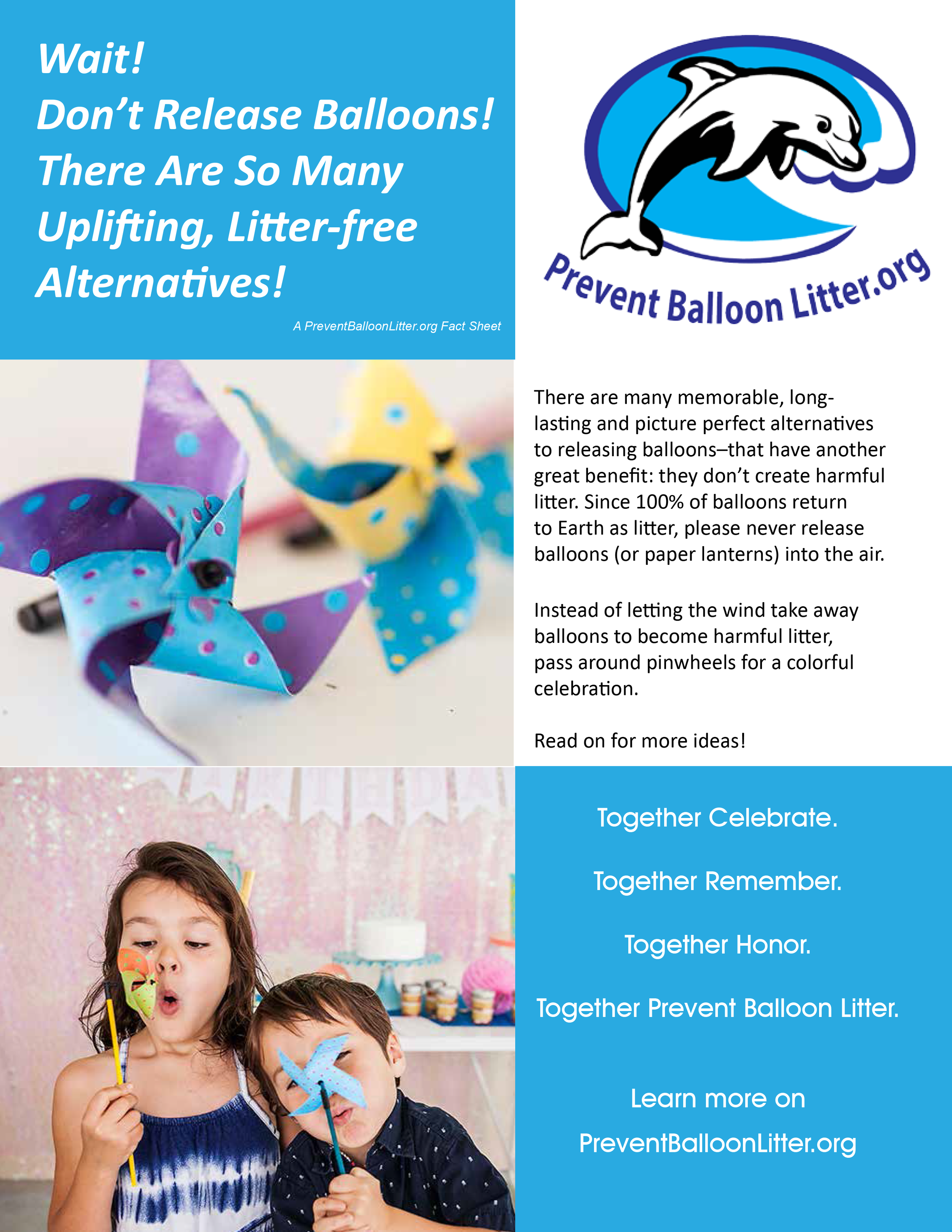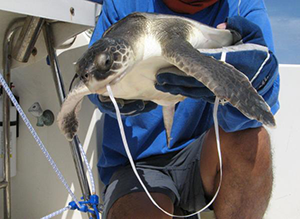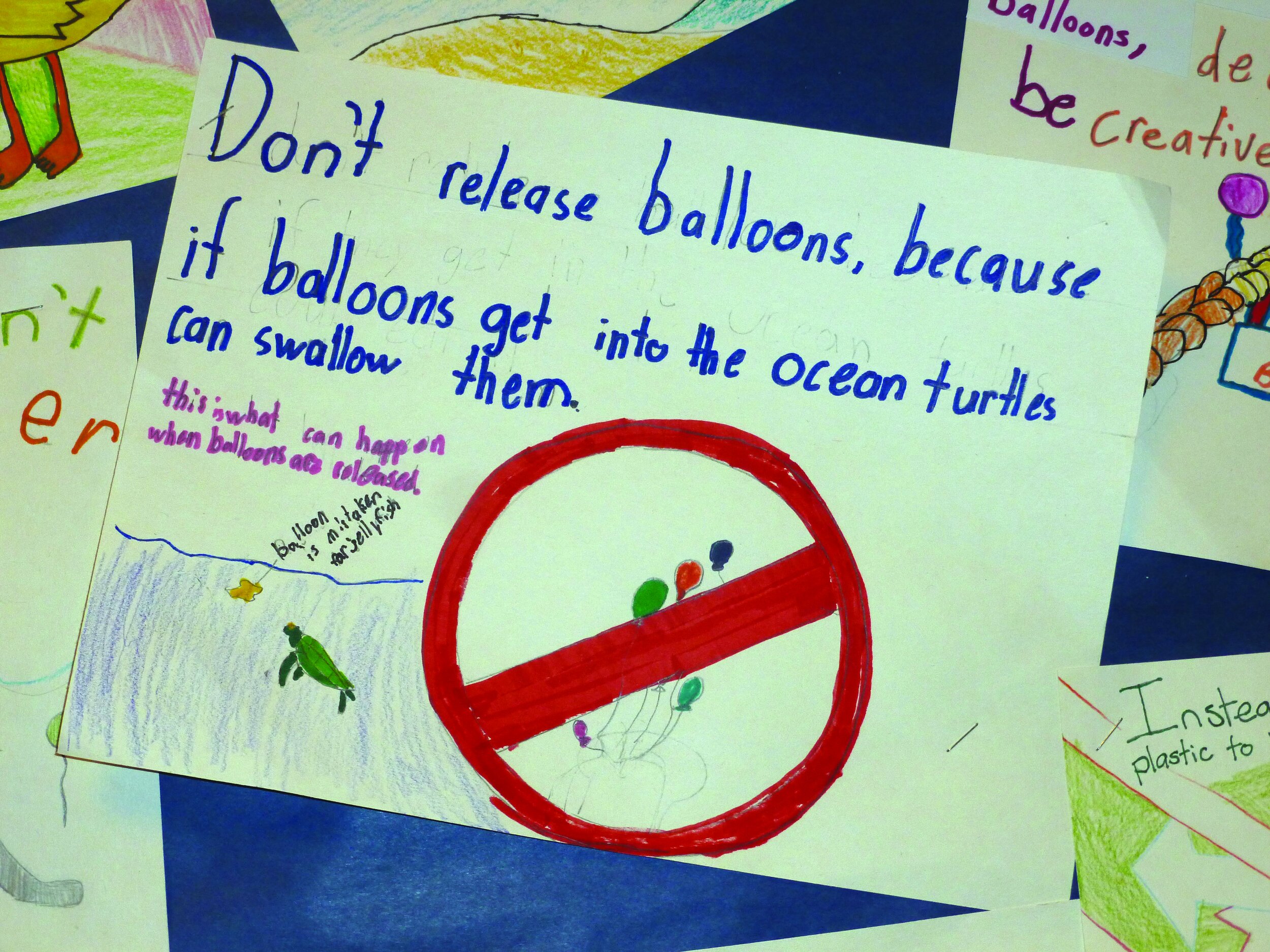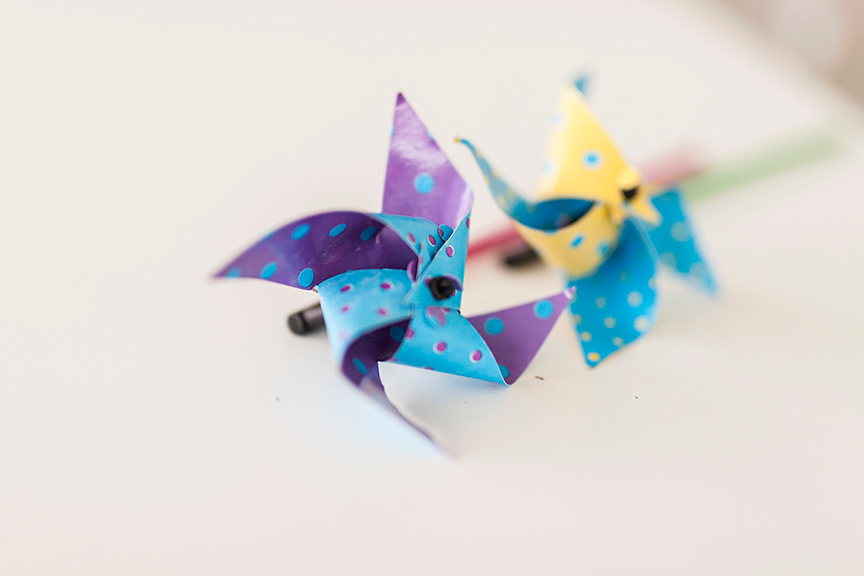Media Partners Needed
Please help share positive stories of the alternatives to balloon release!
As a media outlet, you are a trusted public messenger in a unique position to help implement change.
The visual display of balloon release events covered by the media makes it difficult to overcome the social acceptance that leads to peoples’ decisions to participate in, or plan, a mass release.
Your help in sharing stories of communities gathering without a balloon release will help shift the norm and encourage meaningful alternatives. It is the ceremony of coming together to remember or to celebrate a cause or loved-one that is most important.
Our goal is to reach as many people as possible and encourage alternatives to balloon releases. Please partner with us and help Prevent Balloon Litter.
The Prevent Balloon Litter Campaign encourages people to learn about balloon litter - that released balloons do become harmful litter, to select alternatives to releasing balloons - to celebrate, honor and remember people and events, to pledge to use one of these alternatives and help prevent balloon litter, and to encourage others to do the same.
Below is more background information on our effort and the resources available to you. We would enjoy speaking with you about opportunities to work together.
Please reach out to us at PreventBalloonLitter@gmail.com.
Why our focus on balloon Litter?
All released balloons and their attachments eventually return to Earth as litter, landing in the ocean, inland waterbodies, or on land. Balloons are unique among all the man-made litter. People often purchase balloons with the intent to release them into the environment. Once airborne, released balloons can travel long distances, some hundreds of miles, before they burst or deflate. Once back on land or in the sea, balloons and their attachments become a deadly threat to wildlife. Scientists who work with stranded whales, dolphins, seals, and sea turtles have found balloons, balloon pieces, and balloon ribbons in the stomachs of many of these dead animals. Balloon ribbon can also wrap around fins, flippers, wings, and limbs - leading to starvation, infection, amputation or drowning.
In addition to wildlife impacts, there is evidence that up to 20% of electrical power outages are caused by foil balloons getting tangled in power lines. According to one employee of a utility company, balloons released on Valentine’s Day, Mother’s Day, Easter, graduations and at weddings bring outages, “almost without fail.” Several electrical providers’ websites and notices to customers include “don’t release balloons” messages for this reason.
The Mid-Atlantic Regional Council on the Ocean (MARCO) – the recognized Regional Ocean Partnership in the Mid-Atlantic representing the states of Virginia, Delaware, Maryland, New Jersey, and New York – has partnered with several aquariums on a campaign to turn the tide on intentional balloon release behavior. This campaign, Prevent Balloon Litter, seeks to change the social norm around intentional balloon releases.
Media Resources
-

Balloon Litter and Impacts Factsheet
Balloon Debris: A Rising Concern -
Fact sheet on the types of balloon litter and the impacts of balloon litter.
-

Alternatives to Balloon Release Factsheet
Wait! Don’t Release Balloons! -
Flyer (2 pages) highlighting many uplifting, litter-free alternatives to releasing balloons.
-

Balloons Cause Power Outages Fact Sheet
Metallized foil balloons (incorrectly referred to as Mylar) that become entangled in power lines can cause wide-spread power outages because of their electrical conduction properties. This fact sheet outlines examples of power outages known to be caused by foil balloons in Virginia, Maryland, DC, California (southern and Los Angeles) and Arizona.
-
Animated Videos
Balloon Litter: Say No to Letting It Go!
This animated video - 2:08 minute in English and 2:26 minute in Spanish - highlights the impacts of balloon litter and suggests alternatives to releasing balloons during events to celebrate and remember.
-
Pledge
Central to the campaign is encouraging people to take an on-line or in-person pledge to never release balloons, but instead to select from many alternatives to celebrate without releasing balloons. Once they complete the an in-person pledge, they get a pledge decal to show others their commitment.
-

Poster - Alternative to Balloon Release
-

Poster - Alternative to Balloon Release
-

Poster - Alternative to Balloon Release
-

Poster - Impact of Balloon Litter
This image shows a Puffin entangled in balloon ribbon. The image was taken by Jill Fraser-Smith off Staithes, North Yorkshire, UK in the North Sea on 13 August 2017.
-

Poster - Impact of Balloon Litter
This juvenile Kemp’s ridley (Lepidochelys kempii, about 2 yrs old) ingested a latex balloon with ribbon. The turtle was in a sargassum drift (it’s habitat) approximately 50 NM west of Sarasota, FL in the Gulf of Mexico. A latex/ribbon-knot was lodged in the turtle’s esophagus and was removed on July 11, 2009. Image taken by Blair Witherington, a research scientist.
-

Poster - Impact of Balloon Litter
The horse in the picture is a (then) 2.5 year old filly named Alexandria's Angel (N9BFT-KP). The image was taken by Cat Volmer in May 2020 on the Maryland side of Assateague Island National Seashore. Luckily, Alexandria dropped the balloon, but they are a real threat to horses, especially when the strings get tangled in the grass they eat. Even more so because unlike most species, horses can't really vomit except in rare cases.
Prevent Balloon Litter Campaign Logos
Images of Balloon Impacts and Alternatives
Note: Images featured in posters available upon request.
The Prevent Balloon Litter campaign materials included on the Press Room page were produced by the Virginia Coastal Zone Management Program through grants from the NOAA Office for Coastal Management and Marine Debris Program, and by MARCO with a grant from the NOAA Marine Debris Program for a Prevent Balloon Litter Campaign in the Mid-Atlantic.

































